Phaser Technology
From Star Trek: Theurgy Wiki
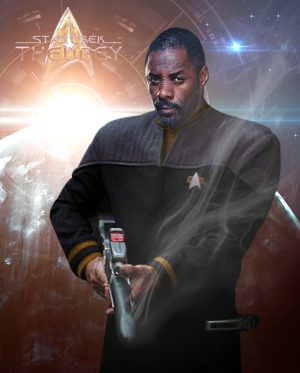
|
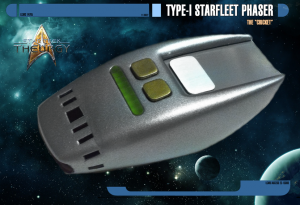
|
| Type-I Phaser |
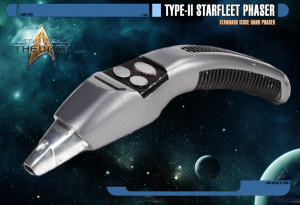
|
| Type-II Phaser |
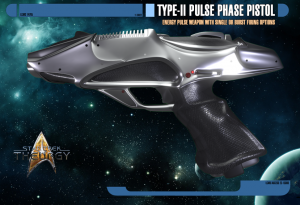
|
| Type-II Pulse Phase Pistol |
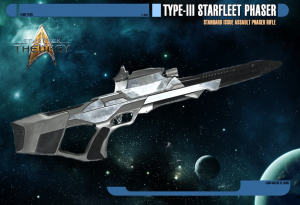
|
| Type-III Phaser Assault Rifle |
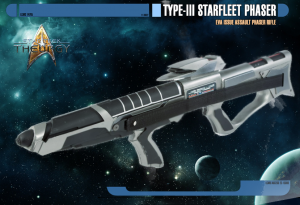
|
| Type-III EVA-issue Phaser Assault Rifle |
Phasers (an acronym for PHASed Energy Rectification) were the most common and standard directed energy weapon in the arsenal of Starfleet and several other powers. Most phasers were classified as particle weapons and fire nadion particle beams. Based on the intensity and field of the beam and a variety of adjustments, a wide variety of effects could be achieved. All Starfleet phasers followed a similar naming convention, with the lowest being handheld and each higher number becoming more powerful and larger in size. After the Type-III, Phasers were too unwieldy to be hand operated and required such power that they were only suitable to be attached to vehicles, vessels or outposts.
Handheld Phasers
Utilized primarily in defensive situations, Handheld phasers had several applications, from use as a weapon to use as a cutting tool, explosive device, or energy source. Storing considerable energy, most phasers were distinguished by their size and firing capabilites, with all models able to output a focused energy discharge in the form of a beam or steady stream.
Type-I
Colloquially know as the "Cricket", the type-I phaser was the smallest, most basic weapon carried by Starfleet and other Federation personnel. Easily concealable, the type-I was able to be programmed to fire automatically at set intervals. However, due to the lack of its operating capabilities, longevity and diversity when compared to its larger brethren, the type-I phasers were typically only carried when it would be inappropriate to carry a larger weapon, such as on diplomatic missions. Because of this, the type-I was synonymous with secret missions and seldom seen in active use.
Type-II
The type-II was the standard weapon used aboard all Starfleet vessels and bases, as it offered a very favorable compromise between size and power. Originally designed to encompass the type-I, the type-II held a pistol-like grip. By the 2360s, the type-II had evolved past that configuration, becoming a sleek, silver-colored device with a handle flowing into the form of a muzzle cowling and emitter. The type-II phaser is a required piece of equipment for most Starfleet away teams, and is the basic sidearm of Starfleet security teams
With two small buttons for beam width and intensity control and a large one to fire the device, the type-II featured a large, illuminated power level readout. The phaser retained the functionality of the previous designs, but increased the power and versatility. Like their predecessors, these units could be adjusted for use as cutting tools or power sources. They could also be set to overload, becoming a powerful explosive device.
In addition to more variable power settings than the Type-I, Type-II Phasers are able to be set for a "narrow" (affecting a single target) or "wide" beam (affecting two or more targets over a certain area). The frequency of the beam may also be adjusted to make it more effective against certain types of shields and/or force fields.
Type-II Pulse Phase Pistol
During the Dominion War, it became apparent that single beam particle weapons were ineffective against groups of Jem’Hadar. As such, Starfleet Security desired the ability to fire multiple short pulses of energy. The Type-III rifle was easily modified with a change of beam emitter, but due to the smaller size, the Type-II was unable to be modified in such a way.
With the need of a small weapon for use in close quarter situations, this handphaser variant Type-II Pulse Phase Pistol was created. Not only to be easily distinguishable between the conventional Type-II and this pulse fire variant, but to also account for an increased need for stability and accuracy, this new weapon took design elements of more traditional handheld weapons, incorporating a pistol-like grip and hard sight points along the top of the device.
Because of the difference in shape and fire pattern, Starfleet Personnel required further training on this weapon in addition to standard phaser profiency. As such, the type-II Pulse Phase Pistol was standardly reserved for Security and Tactical Conn personnel.
Type-III
The largest standard phaser issued to Starfleet personnel, the Type-III (or simply referred to as the phaser rifle) was a two handed weapon capable of greater accuracy and longevity that its type-II counterpart. Even though the type-III had a much greater energy reserve, this only translated to an increase of longer periods of fire rather than any rise in output levels over one-handed phasers. Phaser rifles were not standard landing party equipment aboard Starfleet vessels. Typically, rifles were equipped only when firepower heavier than that of the type-II phaser was required.
Originally a bulky device with the capability of its rear handle to be rotated into a shoulder stock, the type-III was more streamlined and smaller by the 2360s. In the early 2370s, the need for accuracy caused the design aesthetic of the weapon to change once again, this time the rifle returned to having a shoulder stock but also incorporated a rear pistol-like and front under barrel grip, a combined sight and tactical light, and an integrated shoulder sling for ease of carrying.
The outbreak of the dominion war caused a need for weapons to fire in multiple bursts rather than just a single beam of energy. Starfleet Security created two new weapons for this purpose - the Type II Pulse Phase Pistol and the Type-III Phaser Compression Rifle. By 2375, the Compression Rifle was removed from service, due to comparable capabilities produced from the standard type-III with a change to its beam emitter. The switch between the angular and smooth beam emitters on the type-III rifles allowed the weapons to fire both single beam and pulses of energy at will by the operator.
After the completion of the dominion war, in the late 2370s, Starfleet Security updated the sights of the type-III to a red holographic style allowing for great accuracy and target acquisition. The integrated flashlight was unaffected.
Type-III EVA Variant
During the 2370s, Starfleet produced an additional variant of the type-III specifically designed for EVA missions. This rifle had unique features including, two pistol-like grips for ease of handling, no trigger guard to allow for use by personnel wearing EV Suits, and magnetic areas allowing the rifle to be attached to a ship's hull.
This variant was later removed from service by Starfleet, however due to its popularity among officers, there are still many units available in the field. Ryuan Sel, the Mistress-of-Arms of the USS Theurgy was known to prefer this weapon.
Phaser Rifle Evolution
Settings
All handheld Phaser used a common scale to denote the power output of the weapon, however not all phasers could achieve the highest settings. type-I Phasers are only able to reach settings 1-8, whereas type-II and type-III are able to make use of all sixteen.
| Power Setting | Effect | Notes |
| 1 | Light Stun |
|
| 2 | Medium Stun |
|
| 3 | Heavy Stun |
|
| 4 | Low Thermal |
|
| 5 | High Thermal |
|
| 6 | Low Disruption |
|
| 7 | Moderate Disruption |
|
| 8 | Medium Disruption |
|
| 9 | High Disruption |
|
| 10 | Extreme Disruption |
|
| 11 | Slight Explosive |
|
| 12 | Low Explosive |
|
| 13 | Moderate Explosive |
|
| 14 | Medium Explosive |
|
| 15 | High Explosive |
|
| 16 | Extreme Explosive |
|
Vessel-mounted Phasers
Originally, starships used phaser banks. Each bank contained one or more phaser emitters from which the beam energy was released. These systems shared common power sources and targeting systems. In the 2270s, phaser power systems of Federation starships were redesigned to channel power directly from the warp core, thereby increasing the power output of phaser banks.
By the 24th century, the number of emitters in each bank had been increased to the point where they were laid out in long strips called phaser arrays. The arrays aboard a Galaxy-class starship could channel vast energy in a short time frame, capable of cutting through a mile of solid granite in seconds. Starship-mounted phasers were normally set to fire steady streams of phaser energies that would travel along the emitter strip and converge at the best position for targeting. Following the Battle of Wolf-359, Starfleet Engineers were also able to reconfigure the emitters in a different layout that allowed the phaser bank to rapid-fire as phaser cannons.
In addition to the powerful settings, the ship's phasers also had a stun setting that could be used to render lifeforms unconscious when fired at a planetary surface from orbit. It was also possible to configure starship phasers to also fire energy beams for power transfer.
Types
There were many different type of phasers mounted to starships, standardly as new phaser technology was available, it was placed onto the ships being built at the time. Below are a few examples of phaser types mounted to various ship at the time of their initial construction.
- Type-6 Shuttlecraft were know to operate with type-IV Phasers
- Excelsior class vessels were originally fitted with type-VIII Phasers
- Galaxy and Intrepid class vessels were originally fitted with type-X Phasers
- Theurgy class vessels were fitted with type-XI Pulse Phasers

